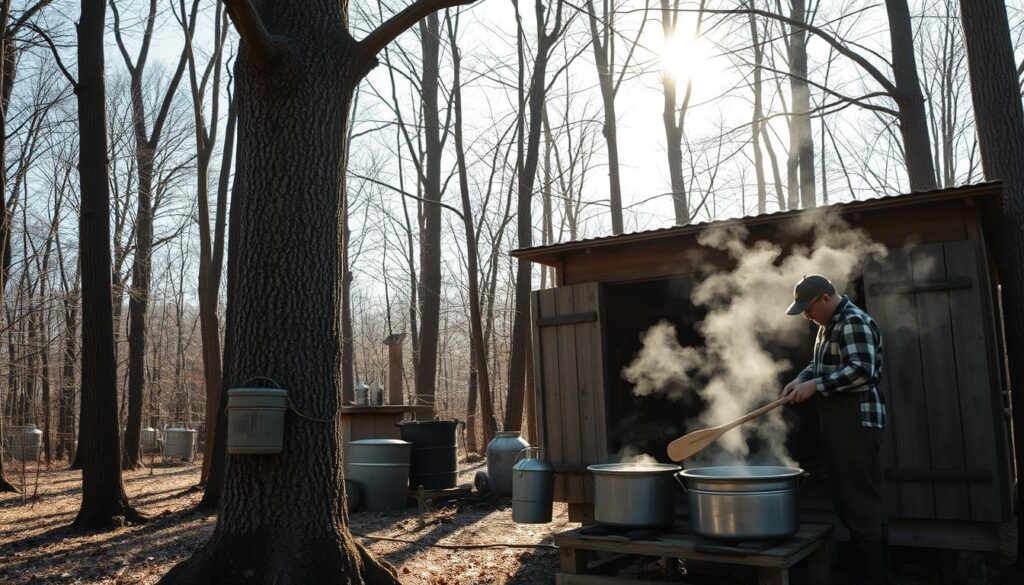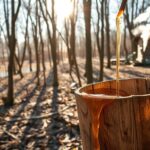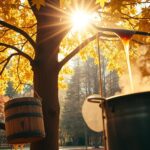Liquid gold flows from Canadian forests, bringing a taste that makes moments special. Canadian maple syrup is more than sweet—it’s a cultural treasure passed down through generations.
Authentic Canadian maple syrup is the sweetest natural thing you can find. It’s made in a special way and comes from the best places in Quebec, Ontario, and New Brunswick. These places have the perfect environment for making the world’s best maple syrup.
Every drop of syrup has a story. Sugarmakers use old techniques to get sap from maple trees at the right time. They work hard to make this simple tree liquid into a complex, delicious treat loved all over the world.
The magic of Canadian maple syrup is in how it’s made. It meets strict Canadian standards. From the forest to your table, it’s a symbol of national pride and caring for the environment.
Canadian maple syrup is not just tasty; it’s also good for you. It has minerals like manganese and zinc, making it a healthier choice than other sweeteners. It connects us to nature with its pure, natural taste.
Exploring the secrets of Canadian maple syrup shows why it’s unmatched worldwide. It’s a proof of nature’s amazing ability to create something truly special.
The Rich Heritage of Canadian Maple Syrup Production
The story of authentic Canadian maple syrup goes back thousands of years. It’s deeply rooted in the culture of North America’s indigenous communities. Traditional maple syrup harvesting is more than just making food. It’s a deep connection between people and nature.
Indigenous Peoples’ Historical Connection to Maple Sap
Indigenous communities were the first to turn maple tree sap into sweet syrup. They knew how to collect sap from trees long before European settlers came. Their knowledge of forests and seasons helped them create advanced sap collection methods.
- Used wooden tools for initial sap collection
- Developed innovative boiling methods using heated stones
- Considered maple sap a vital nutritional resource
Evolution of Maple Syrup Making in Canada
When European settlers learned from indigenous peoples, maple syrup production changed. Metal tools replaced wooden ones, and better boiling methods were found.
| Era | Key Developments |
|---|---|
| Pre-1800s | Indigenous hand-crafted wooden tools and stone boiling |
| 1800-1900 | Introduction of metal spiles and large metal boiling pans |
| 1900-Present | Mechanized collection and precision evaporation techniques |
Cultural Significance Through Generations
Authentic Canadian maple syrup production is a treasured tradition passed down in families. Maple sugaring is a powerful link to Canada’s natural heritage. It shows resilience, innovation, and respect for the environment.
What Is So Special About Canadian Maple Syrup?
Canadian maple syrup is a top-notch sweetener that brings out the best in natural sweetness. It’s special because of its unique blend of geography, culture, and how it’s made.
Several key elements make Canadian maple syrup stand out:
- Pure Natural Processing: It’s collected straight from maple trees in well-managed forests. This keeps its true taste intact.
- Strict Quality Standards: Producers follow strict rules to make sure only the best syrup gets to us.
- Its unique terroir gives it a special taste.
- It’s made with skill passed down through generations of maple farmers.
What really sets Canadian maple syrup apart is its complex flavor. Every drop is a mix of sweetness and subtle flavors. These flavors come from the maple forest and how it’s harvested.
Canadian maple syrup is not just a sweetener—it’s a celebration of nature’s remarkable ability to create something extraordinary.
The syrup’s deep color, smooth feel, and rich taste make it unique. Sugarmakers watch over every step to ensure top quality and taste.
The Unique Geography and Climate That Creates Perfect Syrup
Canada’s maple syrup production is a result of special geography and climate. These factors turn ordinary tree sap into top-notch maple syrup. The country’s unique landscape is perfect for making pure maple syrup with great flavor and quality.
The magic of maple syrup starts with Canada’s special winter-spring change. This time is key for syrup’s taste and richness. Certain environmental factors come together to make the syrup harvesting process ideal.
Impact of Canadian Winter-Spring Cycles
Canadian winters are key for maple syrup making. Sugarmakers need the right temperature changes to get sap flowing:
- Temperatures must drop below freezing at night
- Daytime temperatures need to rise above 40°F (4°C)
- These temperature swings create natural pressure changes in maple trees
Ideal Soil Conditions in Maple Forests
Soil type greatly affects maple syrup quality. The rich, mineral-rich soil in Canadian maple forests adds special qualities to the syrup.
| Soil Characteristic | Impact on Maple Syrup |
|---|---|
| pH Level | Neutral to slightly acidic soil produces best results |
| Mineral Content | Enhances flavor complexity and depth |
| Drainage | Well-drained soil supports healthy maple tree growth |
Regional Terroir Differences
Every maple-producing area in Canada has its own subtle nuances in maple syrup. From Quebec’s traditional forests to Ontario’s varied landscapes, each region adds its own flavor. This makes Canadian maple syrup truly unique.
“The earth speaks through every drop of maple syrup, telling a story of climate, soil, and tradition.” – Canadian Maple Syrup Expert
Understanding Different Maple Syrup Grades
Canadian maple syrup grades show a detailed system. It highlights the top-notch maple syrup made across Canada. This grading ensures quality and unique flavors for various dishes.
The Canadian grading system looks at color, flavor, and light. Each grade has its own taste and appeal. This suits different tastes and cooking needs.
- Golden Color, Delicate Taste: Lightest grade with subtle maple flavor, perfect for baking and drizzling over desserts
- Amber Color, Rich Taste: Medium-intensity maple flavor, ideal for general table use
- Dark Color, Robust Taste: Strong maple flavor, excellent for cooking and marinades
- Very Dark Color, Strong Taste: Most intense maple flavor, best for industrial processing
Expert sugarmakers watch over the syrup making closely. They keep to strict grade standards. The syrup’s color and taste change based on sap timing, tree health, and how it’s made.
Knowing these grades helps pick the right maple syrup. It ensures the syrup fits your cooking style and taste preferences.
The Science Behind Maple Syrup Production
Pure maple syrup is a magical change from tree sap to a tasty natural sweetener. The journey of making maple syrup involves complex biological and chemical steps. It needs careful attention and skill.
The heart of making maple syrup sustainably starts with knowing maple forests well. Sugarmakers watch over tree health and sap flow closely. They do this to harm the environment as little as possible.
Sap to Syrup Transformation Process
Maple sap has about 2-3% sugar, which changes a lot during processing. The process includes:
- Collecting raw sap from maple trees
- Removing water through evaporation
- Concentrating sugars to create syrup
- Reaching a precise 66-67% sugar concentration
Modern Production Technologies
Today’s maple syrup making uses new tech to improve efficiency and quality. Tools like reverse osmosis systems and digital monitoring help sugarmakers. They make sustainable maple syrup production better.
Quality Control Measures
Quality checks are strict to ensure pure maple syrup meets Canadian standards. Producers check many times during processing. They make sure of:
- Consistent flavor profile
- Optimal sugar concentration
- Absence of contaminants
- Proper color grading
The science of maple syrup making mixes old wisdom with new tech. It creates a special natural product. It celebrates Canada’s rich farming history.
Sustainable Harvesting Practices in Canadian Forests
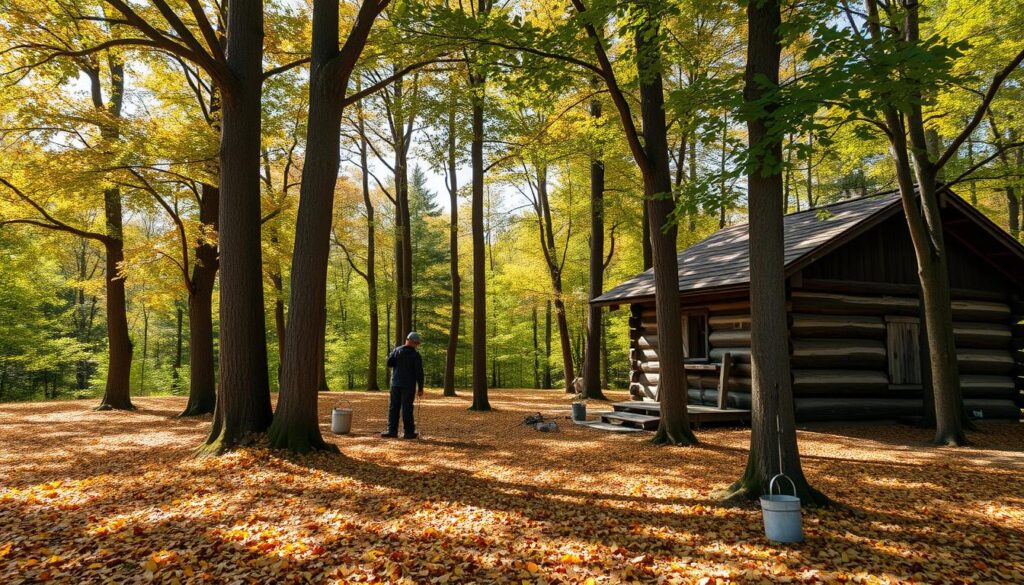
Canadian maple syrup producers are leaders in sustainable production. They use new methods that protect forests and keep syrup quality high. They aim to balance harvesting with conservation, showing their care for the environment.
They follow several key strategies for sustainable organic maple syrup production:
- Selective tree tapping that minimizes forest impact
- Maintaining forest biodiversity
- Implementing regenerative forest management techniques
- Protecting wildlife habitats during maple syrup harvesting
Today’s sugarmakers use the latest tech to lessen their environmental impact. They watch over maple tree health, making sure each tree gets the right care. This way, they keep forests healthy for the future.
Organic maple syrup production goes even further in caring for the environment. Producers steer clear of synthetic chemicals, using natural methods to manage forests. This not only helps the environment but also makes syrup that’s pure and tastes great.
Forest conservation is not just about preservation, but about creating a sustainable relationship between human needs and natural ecosystems.
The Canadian maple syrup industry is a shining example of sustainable farming. It shows how traditional practices can live in harmony with protecting the environment.
Nutritional Profile and Health Benefits
Canadian maple syrup is more than a tasty sweetener. It has many health benefits beyond its rich flavor. Pure maple syrup has a unique nutritional profile that makes it stand out from other sweeteners.
The health perks of Canadian Maple Syrup come from its high mineral content and strong antioxidants. Unlike refined sugars, maple syrup gives us important nutrients that boost our overall health.
Essential Minerals and Antioxidants
Maple syrup is packed with vital minerals and beneficial compounds. Here are the key nutritional highlights:
- Zinc: Supports immune system function
- Manganese: Aids bone health and metabolism
- Calcium: Promotes strong bones and teeth
- Potassium: Regulates heart and muscle function
Comparative Nutritional Analysis
Looking closer at maple syrup shows it’s better than other sweeteners:
| Sweetener | Mineral Content | Antioxidant Levels |
|---|---|---|
| White Sugar | Negligible | None |
| Honey | Low | Moderate |
| Canadian Maple Syrup | High | Highest |
Choosing maple syrup is a smart move for those looking for a natural sweetener. Its high antioxidant levels fight inflammation and support cell health.
Nature’s sweetest gift: Canadian maple syrup combines incredible taste with remarkable nutritional value.
The Economic Impact of Canadian Maple Syrup
The authentic Canadian maple syrup industry is a big deal in rural Canada. It’s not just a sweet treat; it’s a key player in boosting local economies. It helps make rural areas prosperous.
The maple syrup sector brings many economic benefits:
- It gives jobs to thousands of people in rural areas.
- It makes over $500 million each year from exports.
- It supports about 11,000 maple syrup producers across Canada.
- It opens up big economic chances in areas with lots of forests.
Quebec is the top maple syrup producer, making up almost 70% of the world’s supply. This industry keeps whole communities going. It turns local forests into valuable economic resources.
Canada’s maple syrup is known worldwide. This has made Canada’s farm exports more popular. People around the globe want Canadian maple syrup, which helps farmers get better prices.
“Maple syrup is not just a product, it’s an economic ecosystem that connects Canadian heritage with global markets.”
Maple syrup is closely tied to rural economic growth. Small family farms play a big role in local economies. They keep old farming ways alive and bring in good money.
Certification and Quality Standards
Canadian maple syrup production is a top example of excellence in the food world. The strict certification process makes sure every drop of syrup meets the highest standards.

The Canadian government has set up detailed rules to keep maple syrup production pure. These rules cover many parts of making maple syrup:
- Strict harvesting guidelines
- Precise processing protocols
- Comprehensive quality control measures
- Consistent grading systems
Government Oversight and Regulations
The Canadian Food Inspection Agency is key in keeping maple syrup’s high quality. Their strict rules make sure that:
- Maple syrup has the right sugar content
- Production places are very clean
- Maple syrup can be traced from the forest to the bottle
International Recognition
Canadian pure maple syrup is famous all over the world. International food safety groups always praise Canadian maple syrup as the best natural sweetener. This fame has helped open markets worldwide and made Canada the top maple syrup producer.
“Canadian maple syrup represents the pinnacle of natural sweetener quality and craftsmanship.” – International Food Standards Association
Traditional vs Modern Production Methods
Traditional maple syrup harvesting is a mix of old ways and new tech. Sugarmakers in Canada keep their ancient traditions alive. At the same time, they use modern methods to make production better and greener.
The way maple syrup is made has changed a lot. Old days were all about hard work and simple tools. Now, thanks to new tech, making syrup is faster and more efficient.
- Traditional techniques involved wooden buckets and manual sap collection
- Modern systems use vacuum tubing networks for efficient sap extraction
- Advanced monitoring systems track tree health and sap flow in real-time
There are big differences between old and new ways of making syrup:
| Traditional Method | Modern Method |
|---|---|
| Hand-tapping maple trees | Precision drilling with minimal tree impact |
| Open-pan boiling | Reverse osmosis and energy-efficient evaporators |
| Manual sap collection | Automated tubing and collection systems |
Even with all the new tech, Canadian sugarmakers hold onto the true spirit of syrup making. They mix new ideas with old skills. This way, every drop of syrup keeps its deep cultural roots.
Seasonal Harvesting: From Tree to Table
The art of making maple syrup is a dance with nature and human skill. Every spring, sugarmakers in Canada go into maple forests. They start the process of turning tree sap into pure maple syrup.
The maple syrup journey starts with picking the right trees and tapping them correctly. Harvesters look for mature maple trees that are at least 40 years old and 10 inches wide.
Tapping Techniques
It’s important to tap trees right to keep them healthy and get good sap. Sugarmakers do the following:
- Choose trees with thick bark
- Drill holes at the right angles
- Put in spiles
- Attach bags or tubing
Collection and Processing
Turning sap into syrup needs patience and precision. After collecting, the sap is boiled down. This process makes the sugars more concentrated and adds flavor.
Here’s how much sap it takes to make syrup:
- 40 gallons of sap makes 1 gallon of syrup
- Boiling temperatures must be watched closely
- Little processing keeps nutrients in
Traditional maple syrup harvesting shows the beauty of human skill and nature’s bounty.
Global Demand and Export Markets
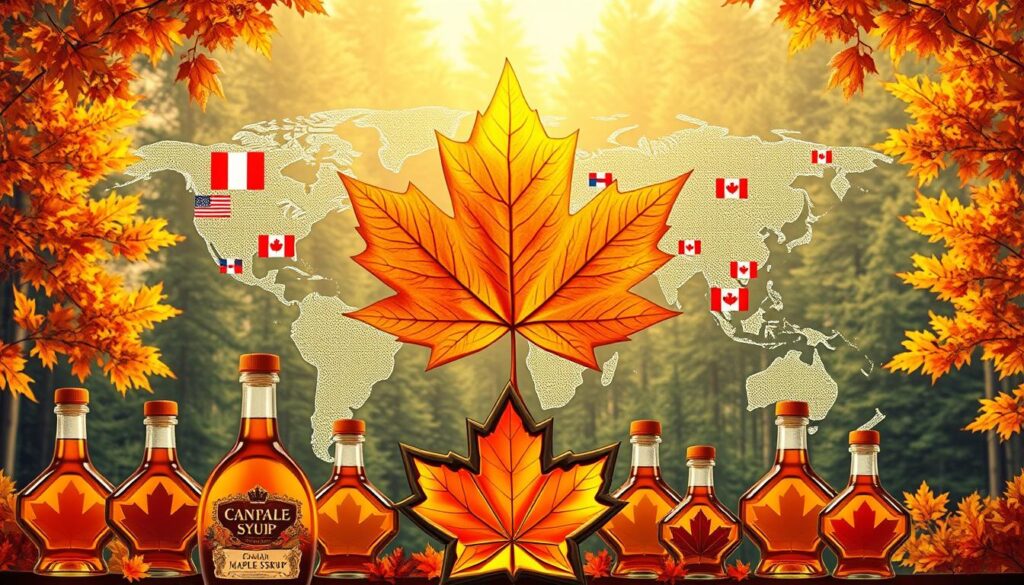
The world loves authentic Canadian maple syrup, making Canada the top producer and exporter. This liquid gold is in high demand globally. Its popularity comes from its unique taste and quality.
In the United States, maple syrup from Canada is a big hit, making up 70% of Canada’s sales. Europe is also a big fan, with Germany, France, the UK, and Japan leading the way.
As the world’s taste for maple syrup grows, so does its value. Export numbers have soared in recent years. This shows how much people value Canadian maple syrup.
| Region | Market Share | Annual Growth |
|---|---|---|
| North America | 65% | 4.5% |
| Europe | 25% | 3.2% |
| Asia-Pacific | 10% | 5.7% |
Culinary sophistication and health-conscious consumers fuel the demand for Canadian maple syrup. Chefs and food lovers appreciate its distinct taste and natural origins.
“Canadian maple syrup represents more than just a sweetener—it’s a cultural emblem of natural quality and craftsmanship.” – Canadian Maple Syrup Association
Asia, like China and South Korea, is showing interest in Canadian maple syrup. This suggests a bright future for this exceptional product.
Culinary Applications and Versatility
Pure maple syrup makes simple dishes into amazing meals. It’s not just for breakfast anymore. Chefs and home cooks love it for its deep flavor.
Maple syrup’s special taste lets chefs get creative. It’s perfect for both sweet and savory dishes. This makes it a favorite in kitchens everywhere.
Traditional Recipe Inspirations
- Classic maple-glazed ham
- Traditional Canadian butter tarts
- Maple-infused baked beans
- Maple pecan pie
Modern Culinary Innovations
Today’s chefs are using maple syrup in new ways. They add it to marinades, salad dressings, and even cocktails. It’s a fancy way to sweeten dishes.
Pairing Suggestions
- Breakfast: Drizzle over pancakes, waffles, and french toast
- Baking: Replace refined sugar in cookie and cake recipes
- Savory Dishes: Glaze roasted vegetables or grilled meats
- Beverages: Sweeten coffee, tea, and cocktails naturally
Canadian maple syrup is loved for its many uses. It’s a top pick in kitchens around the world.
Environmental Factors Affecting Production
Changing environmental conditions pose big challenges to sustainable maple syrup production. Climate shifts are affecting maple forests in Canada and the northeastern United States. This creates big problems for traditional maple syrup producers.
Maple trees need specific temperature ranges to thrive. Organic maple syrup production relies on certain winter and early spring conditions. But these conditions are getting more unpredictable because of global climate changes.
- Rising temperatures reduce sap flow and shorten harvesting windows
- Irregular frost patterns disrupt traditional maple tree tapping schedules
- Increased extreme weather events threaten forest health
Sugarmakers are finding new ways to protect their maple forests. Sustainable forest management practices are key to keeping maple syrup production going for the long term.
Important environmental adaptation strategies include:
- Implementing advanced monitoring technologies
- Developing resilient maple tree varieties
- Creating detailed forest conservation plans
Protecting maple forests isn’t just about production—it’s about preserving a critical natural ecosystem.
Studies show that taking care of the environment can help maple syrup producers face future challenges. By using sustainable practices, they keep this important tradition alive.
Conclusion
Canadian maple syrup is more than a sweetener; it’s a piece of history. It shows the mix of old traditions and new ways to make it. This makes it special.
The syrup’s story is tied to the land and the people who make it. The forests of Canada and the skills passed down through generations make it unique. Every drop tells a tale of hard work and care.
Maple syrup from Canada is loved around the world for its taste and quality. It’s good for you, made in a way that’s kind to the planet, and full of history. It shows Canada’s dedication to keeping traditions alive while trying new things.
As more people look for high-quality, natural foods, Canadian maple syrup shines. It’s a perfect example of how old skills and caring for the environment can create something amazing. It’s loved by many for its taste and its story.

